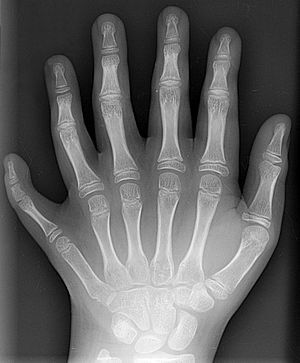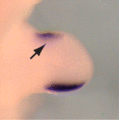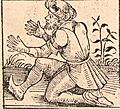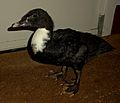Polydactyly facts for kids
Polydactyly is a birth defect that means someone is born with more fingers or toes than usual. It can affect hands, feet, or both. This condition can happen to people, and also to other mammals like dogs and cats. It's usually not harmful and often doesn't cause any health problems.
Contents
What is Polydactyly?
Polydactyly comes from two Greek words: "poly," meaning many, and "dactylos," meaning finger or toe. So, it literally means "many fingers" or "many toes." It's a condition where a person or animal has one or more extra digits. These extra digits can be fully formed, looking like a complete finger or toe, or they might be just a small bump of skin and soft tissue.
How Does it Happen?
Polydactyly usually happens when a baby is developing in the womb. It's often caused by a change in a person's genes, which are like instructions for how our bodies grow. Sometimes, it runs in families, meaning if a parent has it, their child might also have it. This is called an autosomal dominant trait. Other times, it can happen randomly without any family history. It's not caused by anything a parent did or didn't do during pregnancy.
Different Types of Polydactyly
There are a few main ways polydactyly can show up:
- Postaxial polydactyly: This is when the extra digit is on the outside of the hand or foot, next to the little finger or little toe. It's the most common type.
- Preaxial polydactyly: This is when the extra digit is on the inside, near the thumb or big toe.
- Central polydactyly: This is less common and means the extra digit is in the middle of the hand or foot, near the ring, middle, or index fingers or toes.
Polydactyly in Animals
Polydactyly isn't just found in humans! Many animals can also be born with extra digits. For example, some breeds of cats, like the Maine Coon, are known for often having extra toes. These cats are sometimes called "Hemingway cats" because the author Ernest Hemingway had a polydactyl cat, and many of its descendants also had extra toes. Dogs, chickens, and even some types of ducks can also show polydactyly. In many animals, having extra digits doesn't cause any problems and can even be seen as a unique trait.
Treatment and Living with Polydactyly
For many people, an extra digit doesn't cause any pain or problems with daily activities. However, sometimes an extra finger or toe can get in the way, especially if it's not fully formed or if it makes it hard to wear shoes or gloves. In these cases, doctors can often remove the extra digit with a simple surgery. This surgery is usually done when a child is young. People who have polydactyly can live completely normal and healthy lives.
Images for kids
See also
 In Spanish: Polidactilia para niños
In Spanish: Polidactilia para niños











